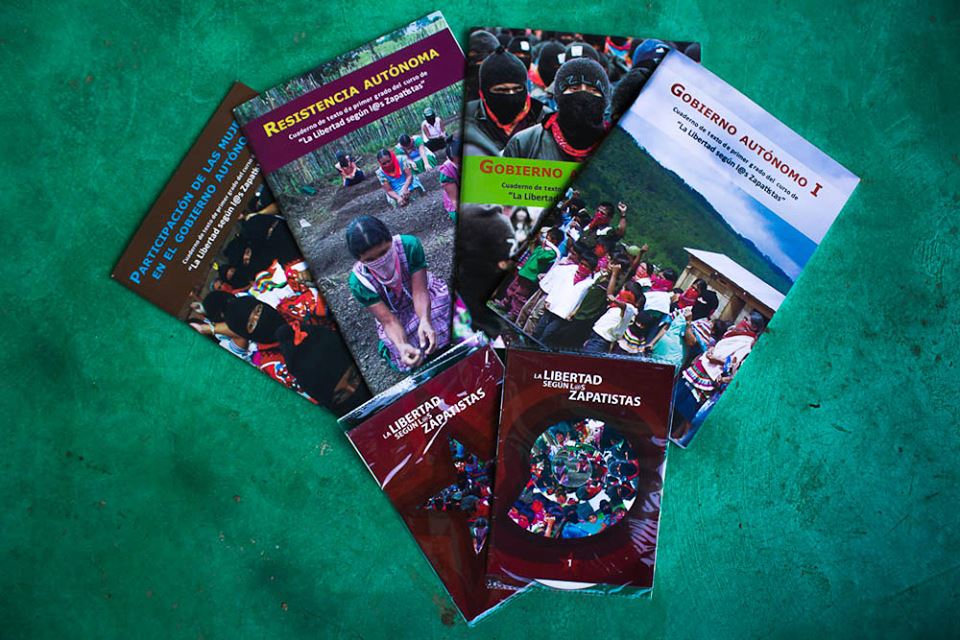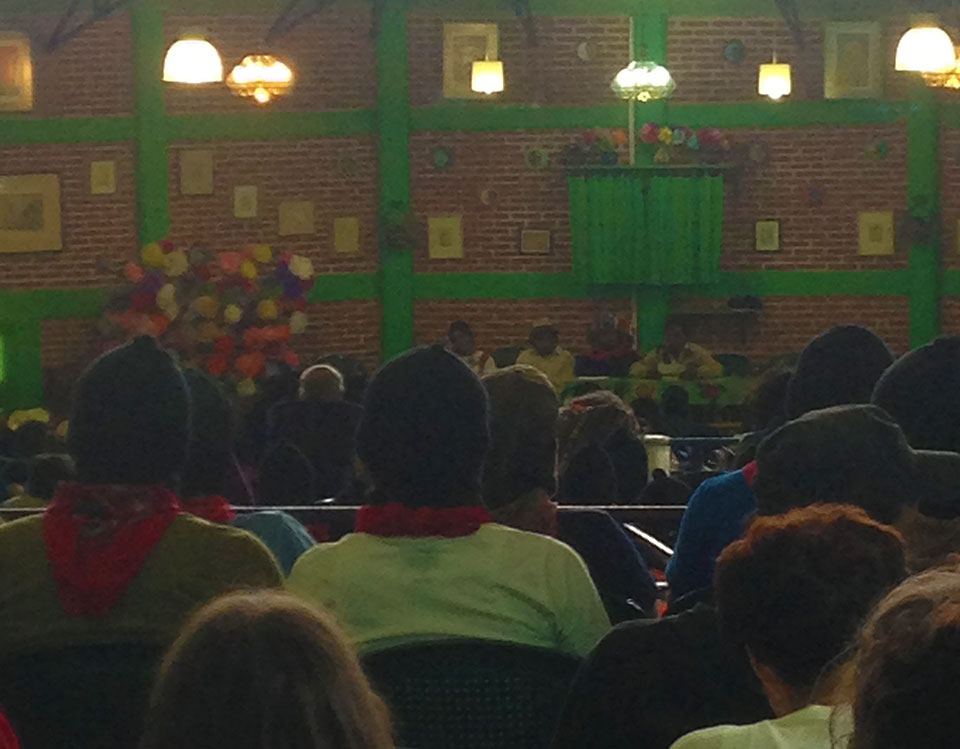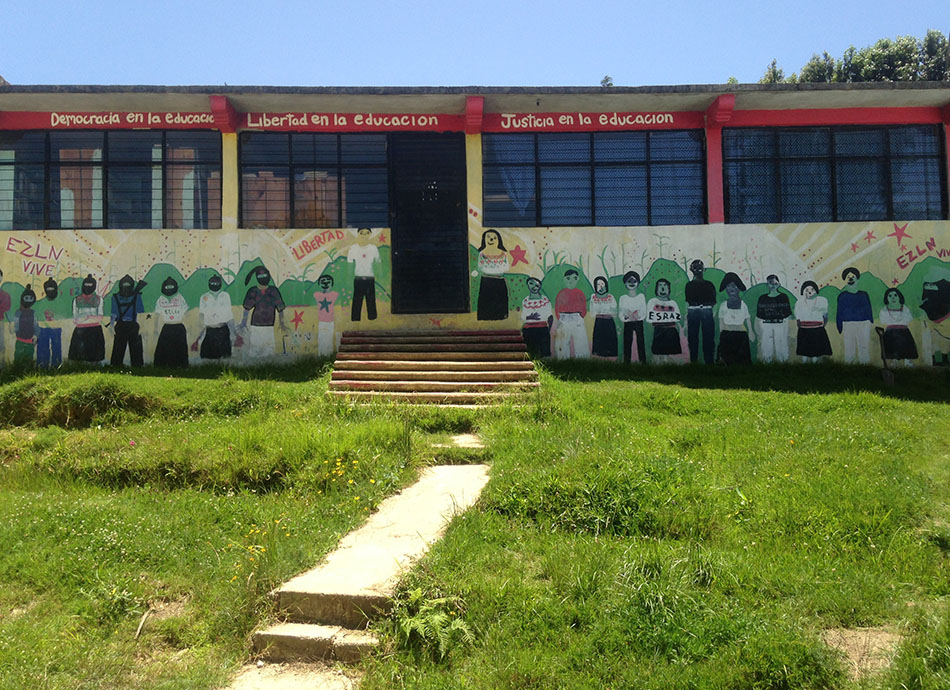Last month, in the mountains of Chiapas Mexico, the Zapatistas hosted over 1700 supporters for the inauguration of their escuelita, or little school, to study freedom according to the Zapatistas.
Applicants accepted to the escuelita traveled from around the world to join the little school from Canada, South Africa, Germany and Brazil. From August 9-18, the students learned Zapatista curriculum and participated in Zapatista community activities.
The timing of the first escuelita coincides with the upcoming 30th anniversary of the Zapatista National Liberation Army (EZLN), the 20th tenth anniversary of the Zapatistas uprising and establishment of autonomous territory, and the 10th anniversary of the “Juntas de Buen Gobierno,” or Councils for Good Government, which govern the municipalities in the territory. It is the lessons of organizing for liberty and enacting autonomy that the escuelita aims to teach supporters.
According to Subcomandante Marcos, a spokesperson for the Zapatistas, liberty is “to govern and govern ourselves according to our ways, in our geography and in this calendar.”

Zapatista Woodstock
To celebrate, the escuelita kicked off with a public, substance free, Woodstock inspired, three-day fiesta in autonomous Zapatista territory. Welcoming speeches were delivered in Spanish and the local Indigenous languages of Tzeltal and Tzotzil. Following the Zapatistas’ poetics of resistance, bands kept the crowd dancing until sunrise playing traditional, folk, rock, and hiphop infused music sets.
Looking across the outdoor basketball court turned dance floor, Zapatistas wearing symbolic black masks danced to the music with unmasked friends and international supporters, collectively forming a rhythmic sea of bodies.
Guests dined on accessibly priced tamales, local varieties of corn, and fried plaintains. When the party-goers tired, sleeping quarters with rustic wood bunkbeds were made available. Even the safe space of the fiesta reflected that Zapatista politics.

Learning liberty
The announcement of the escuelita in a Zapatista communiqué in March invited applications from supporters with “an indisposition to speaking and judging, a disposition to listening and seeing, and a well-placed heart.” The 1700 accepted applicants were divided up to study, work, and live in one of the five Zapatista municipal centres, or caracoles: La Realidad, Oventic, Morelia, Roberto Barrios and La Garrucha.
The students were provided with a study pack for a recommended donation of 100 pesos (equivalent of $8.50 CAN). The study materials consist of two DVDs and four books titled: Autonomous Government 1 and 2, Autonomous Resistance, and The Participation of Women in Autonomous Government.
As an integral component of the five-day immersion curriculum, the students also participated in home stays with Zapatista families preparing meals of beans and tortillas, learning to work in the corn fields, chop wood, and carry water. The host families, teachers and guardians, called *votanes*, assigned to the students overcame language barriers to demonstrate that community and land ground the Zapatistas’ concept of liberty.
A student named Camila from Mexico City elaborated on the teaching methods of the Zapatistas: “They explain through anecdotes, which are reflections of practice.” While Mónica from Uruguay observed: “The Zapatistas wanted us to hear them, to see them, to share with them their experiences of struggle.”

Militaries not invited
The realities of an insurgency living in a heavily militarized zone became clearer as some vehicles transporting students to the caracoles were stopped at military checkpoints, which are scattered throughout the state of Chiapas. While other students discovered how Zapatista communities live with the constant threat of harassment and attack from paramilitaries.
Halfway into the weeklong escuelita curriculum, on August 15 the Zapatistas issued a communiqué denouncing military planes flying over the five Zapatista caracoles. Comandante Tacho of the EZLN declared: “Maybe, serving their masters, the Mexican soldiers are spying for the US government, or, maybe the North American planes are doing the work of spying directly. Or maybe the soldiers want to see what is taught in the Zapatista communities that they have attacked so much, but have been unable to destroy.”

Autonomous movement building
At the conclusion of the week long escuelita, students had understood that autonomy exists and is possible. “Now, we have a mission: that every one of us, in accordance with our ways and places, continue organizing according to our context,” said Mónica from Uruguay. Andalusia added, “The Zapatistas have never asked us to adopt their way of life. What they do ask of us is to stand with them in their struggle and that ‘each of us struggle where you are and construct your own autonomies where you can.'”
Celebrating the success of locally transporting, feeding, housing, and teaching the 1700 students, the Zapatistas concluded the escuelita with the first Tata Juan Chávez Alonso Traveling Seminar. Indigenous peoples from all over Mexico and around the world gathered at the University of the Earth in San Cristóbal de Las Casas for the inaugurate seminar to share strategies for defending territories against the shortsighted exploitation of corporations and governments.

Generating momentum
The Tata Juan Chávez Alonso Seminar plans to re-convene in different regions of the Americas to create a traveling, grassroots forum for Indigenous communities to share solidarity. Meanwhile the Zapatistas have announced that they will host two more escuelitas this coming December and January. For those unable to travel to Chiapas, the escuelita workshops will be broadcast globally by a team of media activists and translators to enable more people to go back to school to study freedom with the Zapatistas.
For more information, please visit here.
Jeh Custerra is a justice activist and performance artist based out of Saskatoon, Saskatchewan. He traveled to San Cristobal de las Casas to study “Art and Resistance” with the Hemispheric Institute for Performance and Politics out of New York University.




